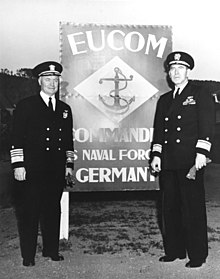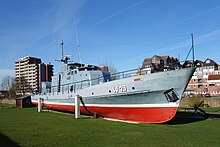United States Naval Forces Germany

The United States Naval Forces Germany (NAVFORGER) was a command of the United States Navy that existed from 1944 to 1958. It carried the numerical designation Task Force 104 (TF-104).
tasks
NAVFORGER was responsible for all American naval activities in Germany. After the command was set up, the first task was to take control of the German warships that had fallen to the USA as spoils of war and to sell them. For this purpose, a German naval service group (MDG) was set up in Bremerhaven .
After the original, purely administrative task, the handling of the German navy and the merchant navy in cooperation with the other allies, was completed, the naval service group was greatly reduced. It was intended to completely disband the NAVFORGER command in 1948. The American military governor General Lucius D. Clay and COMNAVFORGER Rear Admiral Wilkes, who had been in office since July 1948, convinced the leadership in Washington to leave some naval forces in Germany.
The now assigned security and reconnaissance tasks had to be mastered with three main elements, the Naval Advanced Base Bremerhaven, the Rhine River Patrol and a reconnaissance department stationed in Berlin. The duties also included the supervision and administration of civilian shipping on the inland waters of the American zone.
organization
At the head of NAVFORGER was the Commander, Naval Forces Germany (COMNAVFORGER), a naval officer in the rank of Vice Admiral or later Rear Admiral . He was subordinate to the Commander United States Naval Forces Europe ( COMNAVEUR ) whose name was changed in 1946 to Commander US Naval Forces Eastern Atlantic and Mediterranean ( COMNELM ) and in April 1947 to Commander-in-Chief US Naval Forces Eastern Atlantic and Mediterranean ( CINCNELM ). In February 1960 the title of the command was changed again to Commander-in-Chief US Naval Forces Europe ( CINCUSNAVEUR ).
The NAVFORGER command area included various US Navy facilities in the American occupation zone in Germany, which, along with Bavaria , large parts of Hesse , parts of Baden-Württemberg and the American sector of Berlin, was essentially off the coast. In order to have a supply port, the state of Bremen including the city of Bremerhaven was also assigned to the American zone.
The United States Naval Forces Germany were structured as follows (as of 1952):
- Headquarters Heidelberg
- Medical Technical Unit Heidelberg
- US Naval Advanced Base Bremerhaven
- Rhine River Patrol Schierstein b. Wiesbaden
- US Navy Member Military Mission Potsdam
- Sub Headquarters Intelligence Detachment Berlin
In addition to the American members of the armed forces, German personnel were also recruited, which were grouped into three so-called Labor Service Units .
Headquarters and support facilities
The headquarters was set up on July 3, 1945 in Frankfurt am Main and later moved to Heidelberg, where it was housed in the Campbell Barracks , the former Großdeutschland barracks . A support company (Headquarters Company) was part of the headquarters. In addition, a so-called Medical Technical Unit was deployed. There was a German liaison officer at headquarters, officially designated as Labor Service Unit "A" .
In addition, the American naval representative was directly subordinate to COMNAVFORGER at the military mission in Potsdam.

The US Naval Advanced Base Bremerhaven ( NAB , advanced naval base Bremerhaven) was established on July 1, 1945. The necessary construction and repair work on the systems taken over by the Navy was carried out by Task Force 126 , which consists of units from the US Navy ( Seabees ) , the first units of which had arrived in Bremen on April 29, 1945 and in Bremerhaven on May 14. The commander, CTF 126, was also called Commander US Naval Ports and Bases Germany .
organization
The NAB was subject to the following units:
- Marine Service Group (until 1951)
- Weser River Patrol
- Repair unit
- Mine Sweeping Readiness Unit
- Mine Division One
- Mine Division Two
- Communication Unit # 8
- Labor Service Unit (B) (from 1951)
Commanders of the NAB
The NAB was led by a commander who was also the deputy of COMNAVFORGER. The names of the following commanders have survived:
- 1945–1950 was later Captain ( Rear Admiral ) Harold R. Holcomb.
- 1951 Captain Charles FMS Quimby.
- until 1955 Captain Charles W. Moses
- from 1955 Captain John G. McClaughry
Rhine River Patrol
The Rhine River Patrol had its base and headquarters in Schierstein near Wiesbaden. It performed security tasks on the Rhine and was divided into the following units:
- Unit M
- Unit S
- Unit K
- Labor Service Unit "C"
Sub Headquarters Intelligence Detachment Berlin
The NAVFORGER included a reconnaissance element, which was structured as follows:
- Intelligence Office Frankfurt
- Intelligence Office Bremen - Bremerhaven
- Intelligence Office Munich
- Flying unit
Commanders
The following officers have been handed down as Commander Naval Forces Germany:
- 12 / 1944-45 VA Robert L. Ghormley
- 8 / 1945–? RA / VA? William A. Glassford
- 1948-4 / 51 RA John E. Wilkes
- 4 / 1951–1952 RA / VA Carl Holden
- - 1952 – RA / VA? Howard E. Orem
- 3 / 1954–11 / 55 RA Bertram Joseph Rodgers
References
Web links
Individual evidence
- ↑ inventory of the agency
- ↑ a b c d Official site USArmy Germany
- ↑ mandors p. 3 ( Memento of the original from March 5, 2016 in the Internet Archive ) Info: The archive link was inserted automatically and has not yet been checked. Please check the original and archive link according to the instructions and then remove this notice.
- ↑ a b Organigram ( Memento of the original from March 18, 2011 in the Internet Archive ) Info: The archive link was inserted automatically and has not yet been checked. Please check the original and archive link according to the instructions and then remove this notice.
- ↑ mandors p. 4 ( Memento of the original from July 15, 2015 in the Internet Archive ) Info: The archive link was inserted automatically and has not yet been checked. Please check the original and archive link according to the instructions and then remove this notice.
- ↑ Date and place of installation
- ^ History of the 69th Naval Construction Battalion, 69th NCB
- ↑ a b History of the NSGA Bremerhaven, Germany ( Memento of the original from March 18, 2011 in the Internet Archive ) Info: The archive link was inserted automatically and has not yet been checked. Please check the original and archive link according to the instructions and then remove this notice.
- ↑ Obituary
- ↑ a b Weser River Patrol
- ↑ CV
- ↑ CV

